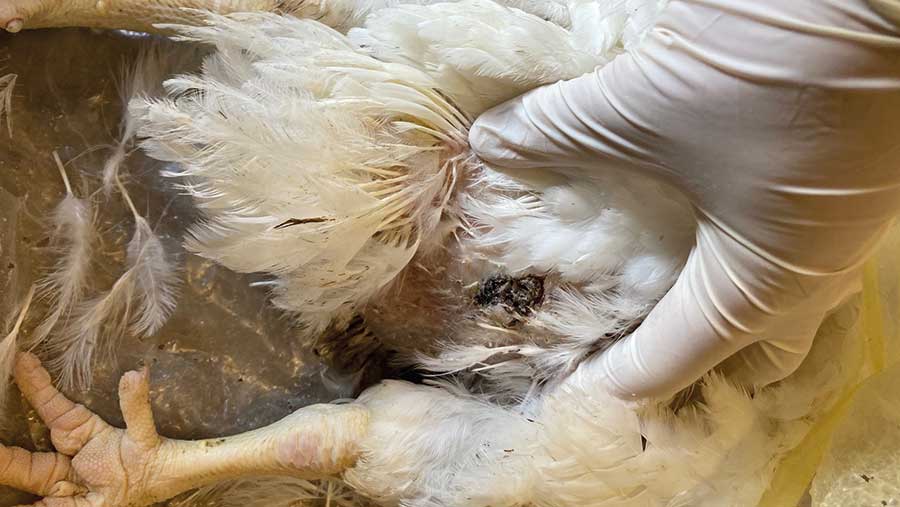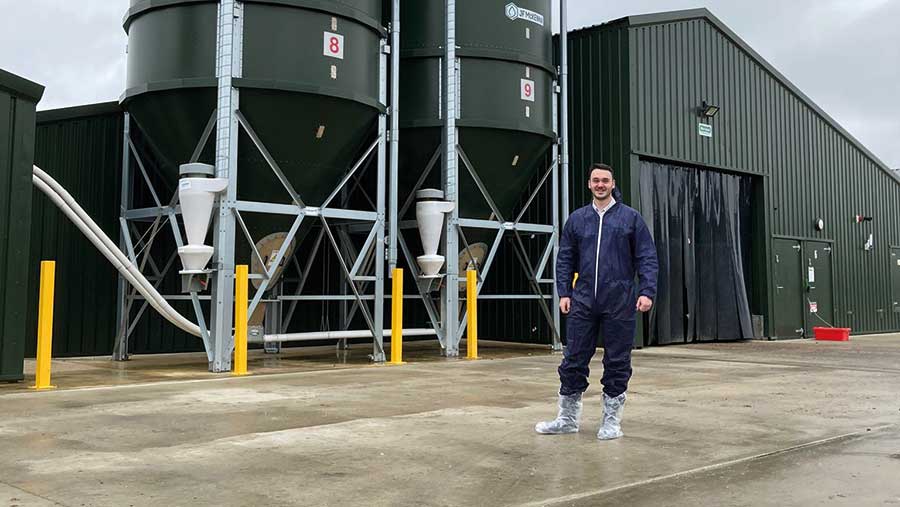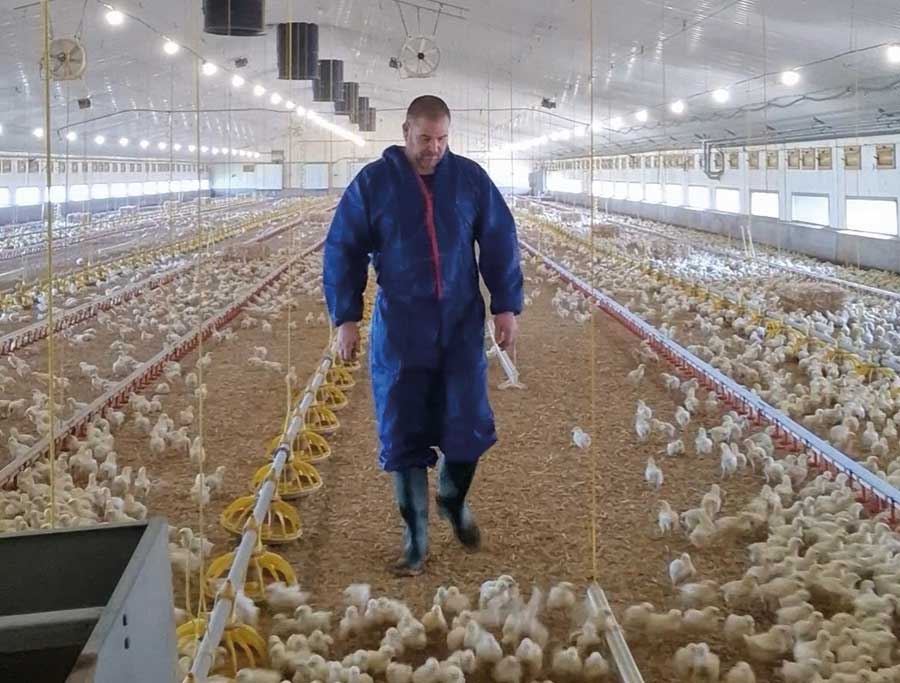Why organic acids are key to reducing cellulitis rates
 © St David’s Poultry Team
© St David’s Poultry Team Since 2010, the number of cellulitis rejects has increased nearly threefold, according to Food Standards Agency data.
“In the early 2000s we were concerned about a 0.5% cellulitis infection rate – now it’s not uncommon to see averages of at least 1%,” says Nathan Hiom, poultry vet at St David’s Poultry Team.
See also: 10 reasons for poultry carcass rejects and how to avoid them
As birds are growing faster, they are becoming more sensitive to challenges in their environment and diet.
Increased light levels in sheds, a result of almost all broiler sheds today having windows, also affects bird behaviour and makes scratches more likely.
That means cellulitis will almost certainly remain an issue, Mr Hiom adds.
Across a batch, producers can expect between 0.3% and 1.2% of birds to be rejected because of cellulitis infections, Mr Hiom says. “But a significant issue can quite quickly lead to rejections of over 2%.
“In some cases up to 10% of birds can be rejected, putting a strain on profitability and likely causing a relatively serious welfare issue,” he adds.
“The biggest risk factor, and the most common source of that bacteria, is compromised water quality,” he explains.
“As with many health issues, immunosuppressive diseases such as Gumboro also have the potential to compromise a bird’s ability to fight off infection, leading to more scratches becoming infected.”
What is cellulitis?
Cellulitis is an infection that presents under the skin – in the subcutaneous layer.
The development of cellulitis requires two components: a scratch wound – often occurring from three weeks onwards – and a bacterial challenge.
Typically the disease develops after a wound has been contaminated with the E coli bacterium.
The birds then excrete the pathogen via their droppings, causing an environmental accumulation of bacteria, which infiltrate other birds through abrasions or scratches.
Six to eight hours later, birds develop subcutaneous oedema, followed by a plaque build-up.
Diagnosing infection
Lameness in a flock is usually a key indicator that a cellulitis problem could be present. “There’s a significant link between lameness and cellulitis,” says Mr Hiom.
“If you’ve got a high level of lameness combined with mortality issues, it’s quite likely there is a systemic bacterial problem.
“This makes birds prone to cellulitis infection due to compromised immune function.
“Cellulitis is confirmed when an obvious and often unpleasant-smelling white/yellow plaque can be found under the skin at post-mortem.”

Nathan Hiom © St David’s Poultry Team
Production impact
When considering the effect cellulitis has on production, it’s important to understand the significance of the link between the gut microbiome and the disease.
“A chicken’s digestive system is either more, or less, hospitable to bacteria depending on what area you’re looking at,” says Mr Hiom.
“The top third is quite acidic, so while some bacteria – both ‘good’ and ‘bad’ – can pass through, it’s difficult for them to populate.”
But when bacteria reach the hind gut – the ileum, and particularly the ceca, the environment becomes more friendly, allowing proliferation.
“When a bird’s gut microbiome balance shifts towards containing more pathogenic bacteria, large numbers build up and gut integrity is compromised,” he says.
Birds then begin to shed increasing amounts of bacteria through their droppings, and the environmental burden rises sharply, increasing the likelihood of cellulitis infection.
Production will be negatively affected, first by compromised gut function and poorer feed conversion ratios (FCRs), and second by cellulitis infections that cause lameness and mortality issues.
A producer can expect an increased cost of about 0.2p a bird for each 0.1% increase in rejects, says Mr Hiom.
How organic acids can help
Developing and maintaining a balanced gut microbiome is key to tackling cellulitis.
“Gut health and cellulitis levels go hand in hand, so we want to promote the growth of ‘good’ bacteria within the gut. To do this, we need to look at gut pH,” he says.
“The complete elimination of E coli from conventional broiler systems is all but impossible.
“However, we now have trials data indicating that the use of organic acids to enhance and manage the gut microbiome can be a valuable tool in fighting the problem.”
Bacteria that aid digestion and promote a healthy microbiome generally like a slightly acidic gut environment. In contrast, pathogenic bacteria prefer a more alkaline balance.
“Organic acids have a role to play here. Towards the end of the gut, pH tends to be close to 7.0, which is neutral. Using organic acids, we can encourage a slightly more acidic balance of around 6.6-6.8pH,” Mr Hiom says.
“This promotes the growth of good bacteria that aid digestion, while restricting the growth of pathogenic bacteria like E coli.”
Historically, the use of organic acids has been cost-prohibitive in the commercial environment, but that is now changing.
And with an ever-increasing drive to reduce antibiotics use, organic acids are becoming a more important tool.
“We have seven trial sites using a broad-spectrum combination of non-buffered organic acids in the water for the first 10 days of life, and a buffered acid for the remainder,” says Mr Hiom.
“All sites are seeing positive outcomes, both in terms of reducing cellulitis rejects and in terms of cost-benefit analysis.
“Across the entire trials group, six out of seven sites saw benefits that exceeded the costs, with the most significant gain being 8.8p/bird.”
Results from organic acid trials
One of the trial sites, Courteenhall Estate’s poultry farm, monitored four crops across different sheds, alternating the use of organic acids.
No antibiotics were used for lameness issues in the flocks that received organic acids, while the others did.
Courteenhall trial results |
|||
|
|
Organic acids |
Growth |
Rejects |
|
Crop 1: Sheds A, B, C and D |
Yes |
107.1% |
1.8% |
|
Crop 1: Sheds E, F, G and H |
No |
102.7% |
2.4% |
|
Crop 2: Sheds A, B, C and D |
No |
105.2% |
1.89% |
|
Crop 2: Sheds E, F, G and H |
Yes |
103.9% |
1.45% |
|
Crop 3: All sheds |
No |
103.6% |
2.3% |
|
Crop 4: Sheds A, B, C and D |
Yes |
104.5% |
2.06% |
|
Crop 4: Sheds E, F, G and H |
No |
106% |
3.5% |

Gavin Smith at Clarks Hill Farm © St David’s Poultry Team
Another trial site, at Clarks Hill Farm near Cheltenham, produces about 850,000 birds a year.
Poultry farm manager Gavin Smith explains that the flock had been experiencing high rejection rates before organic acids were introduced.
“We had a cellulitis reject level that was extremely high – at times as much as 6% – and growth rates were also affected. After consultation with our vet, we agreed to trial organic acids, which produced excellent results.”
The organic acids not only reduced cellulitis reject levels to 2%, but also improved gut health.
“As well as the cellulitis reject issue, we were experiencing a lingering coccidiosis problem, and we had trouble with lameness,” Mr Smith says.
“Introducing organic acids vastly improved our gut health, and helped our coccidiosis and lameness issues. Growth rates have improved, antibiotics use has been greatly reduced, and profits have been boosted.”
